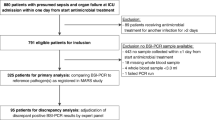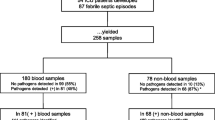Abstract
Objective
Evaluation of the technical and diagnostic feasibility of commercial multiplex real-time polymerase chain reaction (PCR) for detection of blood stream infections in a cohort of intensive care unit (ICU) patients with severe sepsis, performed in addition to conventional blood cultures.
Design
Dual-center cohort study.
Setting
Surgical ICU of two university hospitals.
Patients and participants
One hundred eight critically ill patients fulfilling the American College of Chest Physicians/Society of Critical Care Medicine (ACCP/SCCM) severe sepsis criteria were included.
Interventions
None.
Measurements and results
PCR results obtained in 453 blood samples from 108 patients were compared with corresponding blood culture results. PCR resulted in a twofold higher positivity rate when compared with conventional blood culture (BC) testing (114 versus 58 positive samples). In 40 out of 58 PCR positive assays the results of the corresponding blood cultures were identical to microorganisms detected by PCR. In 18 samples PCR and BC yielded discrepant results. Compared with conventional blood culture the sensitivity and specificity of PCR was 0.69 and 0.81, respectively. Further evaluation of PCR results against a constructed gold standard including conventional microbiological test results from other significant patient specimen (such as bronchio-alveolar lavage fluid, urine, swabs) and additionally generated clinical and laboratory information yielded sensitivity of 0.83 and specificity of 0.93.
Conclusions
Our cohort study demonstrates improved pathogen detection using PCR findings in addition to conventional blood culture testing. PCR testing provides increased sensitivity of blood stream infection. Studies addressing utility including therapeutic decision-making, outcome, and cost-benefit following diagnostic application of PCR tests are needed to further assess its value in the clinical setting.

Similar content being viewed by others
References
Martin GS, Mannino DM, Eaton S, Moss M (2003) The epidemiology of sepsis in the United States from 1979 through 2000. N Engl J Med 348:1546–1554
Angus DC, Linde-Zwirble WT, Lidicker J, Clermont G, Carcillo J, Pinsky MR (2001) Epidemiology of severe sepsis in the United States: analysis of incidence, outcome, and associated costs of care. Crit Care Med 29:1303–1310
Dellinger RP, Carlet JM, Masur H, Gerlach H, Calandra T, Cohen J, Gea-Banacloche J, Keh D, Marshall JC, Parker MM, Ramsay G, Zimmerman JL, Vincent JL, Levy MM (2004) Surviving Sepsis Campaign guidelines for management of severe sepsis and septic shock. Crit Care Med 32:858–873
Gao F, Melody T, Daniels DF, Giles S, Fox S (2005) The impact of compliance with 6-hour and 24-hour sepsis bundles on hospital mortality in patients with severe sepsis: a prospective observational study. Crit Care 9:R764–R770
Rivers E, Nguyen B, Havstad S, Ressler J, Muzzin A, Knoblich B, Peterson E, Tomlanovich M (2001) Early goal-directed therapy in the treatment of severe sepsis and septic shock. N Engl J Med 345:1368–1377
Kumar A, Roberts D, Wood KE, Light B, Parrillo JE, Sharma S, Suppes R, Feinstein D, Zanotti S, Taiberg L, Gurka D, Kumar A, Cheang M (2006) Duration of hypotension before initiation of effective antimicrobial therapy is the critical determinant of survival in human septic shock. Crit Care Med 34:1589–1596
Bochud PY, Bonten M, Marchetti O, Calandra T (2004) Antimicrobial therapy for patients with severe sepsis and septic shock: an evidence-based review. Crit Care Med 32:S495–S512
Harbarth S, Nobre V, Pittet D (2007) Does antibiotic selection impact patient outcome? Clin Infect Dis 44:87–93
Ibrahim EH, Sherman G, Ward S, Fraser VJ, Kollef MH (2000) The influence of inadequate antimicrobial treatment of bloodstream infections on patient outcomes in the ICU setting. Chest 118:146–155
Garnacho-Montero J, Garcia-Garmendia JL, Barrero-Almodovar A, Jimenez-Jimenez FJ, Perez-Paredes C, Ortiz-Leyba C (2003) Impact of adequate empirical antibiotic therapy on the outcome of patients admitted to the intensive care unit with sepsis. Crit Care Med 31:2742–2751
Leibovici L, Shraga I, Drucker M, Konigsberger H, Samra Z, Pitlik SD (1998) The benefit of appropriate empirical antibiotic treatment in patients with bloodstream infection. J Intern Med 244:379–386
Cockerill FR 3rd, Wilson JW, Vetter EA, Goodman KM, Torgerson CA, Harmsen WS, Schleck CD, Ilstrup DM, Washington JA 2nd, Wilson WR (2004) Optimal testing parameters for blood cultures. Clin Infect Dis 38:1724–1730
Magadia RR, Weinstein MP (2001) Laboratory diagnosis of bacteremia and fungemia. Infect Dis Clin North Am 15:1009–1024
American College of Chest Physicians/Society of Critical Care Medicine Consensus Conference Committee (1992) American College of Chest Physicians/Society of Critical Care Medicine Consensus Conference: definitions for sepsis and organ failure and guidelines for the use of innovative therapies in sepsis. Crit Care Med 20: 864–874
Rangel-Frausto MS, Pittet D, Costigan M, Hwang T, Davis CS, Wenzel RP (1995) The natural history of the systemic inflammatory response syndrome (SIRS). A prospective study. JAMA 273:117–123
Sands KE, Bates DW, Lanken PN, Graman PS, Hibberd PL, Kahn KL, Parsonnet J, Panzer R, Orav EJ, Snydman DR, Black E, Schwartz JS, Moore R, Johnson BL Jr, Platt R (1997) Epidemiology of sepsis syndrome in 8 academic medical centers. JAMA 278:234–240
Peters RP, van Agtmael MA, Danner SA, Savelkoul PH, Vandenbroucke-Grauls CM (2004) New developments in the diagnosis of bloodstream infections. Lancet Infect Dis 4:751–760
Lehmann LE, Hunfeld KP, Emrich T, Haberhausen G, Wissing H, Hoeft A, Stuber F (2008) A multiplex real-time PCR assay for rapid detection and differentiation of 25 bacterial and fungal pathogens from whole blood samples. Med Microbiol Immunol 197:313–324
Louie RF, Tang Z, Albertson TE, Cohen S, Tran NK, Kost GJ (2008) Multiplex polymerase chain reaction detection enhancement of bacteremia and fungemia. Crit Care Med 36:1487–1492
Seifert H, (2001) MiQ: Qualitätsstandards in der mikrobiologisch-infektiologischen Diagnostik Heft 3: Sepsis-Blutkulturdiagnostik. Elsevier, Urban & Fischer
Calandra T, Cohen J (2005) The international sepsis forum consensus conference on definitions of infection in the intensive care unit. Crit Care Med 33:1538–1548
Socan M, Marinic-Fiser N, Kese D (1999) Comparison of serologic tests with urinary antigen detection for diagnosis of legionnaires’ disease in patients with community-acquired pneumonia. Clin Microbiol Infect 5:201–204
Kollef MH, Sherman G, Ward S, Fraser VJ (1999) Inadequate antimicrobial treatment of infections: a risk factor for hospital mortality among critically ill patients. Chest 115:462–474
Dellit TH, Owens RC, McGowan JE Jr, Gerding DN, Weinstein RA, Burke JP, Huskins WC, Paterson DL, Fishman NO, Carpenter CF, Brennan PJ, Billeter M, Hooton TM (2007) Infectious Diseases Society of America and the Society for Healthcare Epidemiology of America guidelines for developing an institutional program to enhance antimicrobial stewardship. Clin Infect Dis 44:159–177
Harbarth S, Garbino J, Pugin J, Romand JA, Lew D, Pittet D (2003) Inappropriate initial antimicrobial therapy and its effect on survival in a clinical trial of immunomodulating therapy for severe sepsis. Am J Med 115:529–535
Struelens MJ, de Mendonca R (2001) The emerging power of molecular diagnostics: towards improved management of life-threatening infection. Intensive Care Med 27:1696–1698
Werner AS, Cobbs CG, Kaye D, Hook EW (1967) Studies on the bacteremia of bacterial endocarditis. JAMA 202:199–203
Kreger BE, Craven DE, McCabe WR (1980) Gram-negative bacteremia. IV. Re-evaluation of clinical features and treatment in 612 patients. Am J Med 68:344–355
Cursons RT, Jeyerajah E, Sleigh JW (1999) The use of polymerase chain reaction to detect septicemia in critically ill patients. Crit Care Med 27:937–940
Acknowledgments
Rebecca Rödel and Sabine Mering provided expert technical assistance.
Conflict of interest statement
The authors have no competing interests. The authors, however, received research funding, reagents, and equipment from Roche Diagnostics GmbH for this project.
Author information
Authors and Affiliations
Corresponding author
Additional information
L. E. Lehmann and K-P. Hunfeld contributed equally to the work.
H. Wissing and F. Stüber conceived equally as senior authors of the study.
Rights and permissions
About this article
Cite this article
Lehmann, L.E., Hunfeld, KP., Steinbrucker, M. et al. Improved detection of blood stream pathogens by real-time PCR in severe sepsis. Intensive Care Med 36, 49–56 (2010). https://doi.org/10.1007/s00134-009-1608-z
Received:
Accepted:
Published:
Issue Date:
DOI: https://doi.org/10.1007/s00134-009-1608-z




